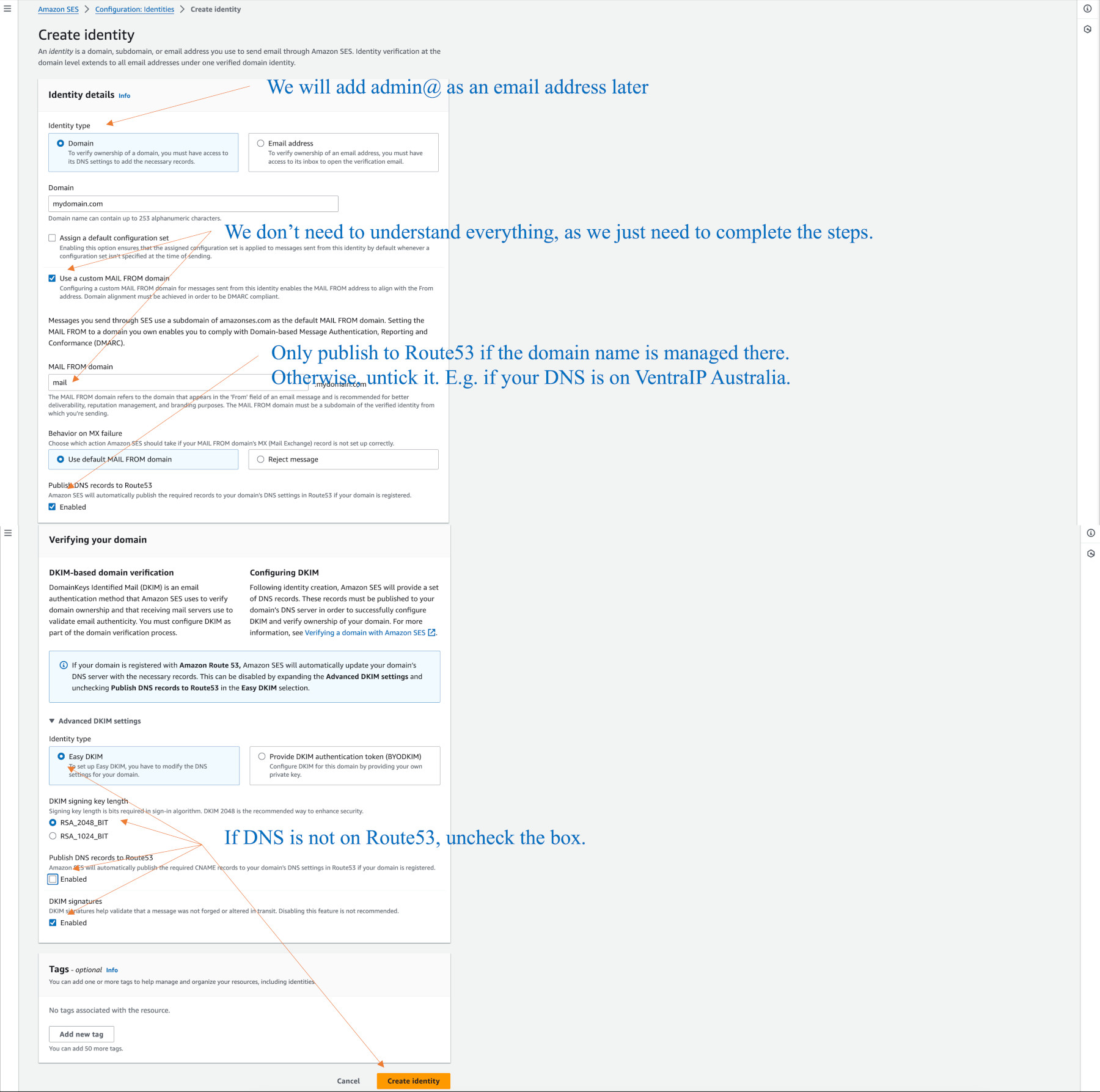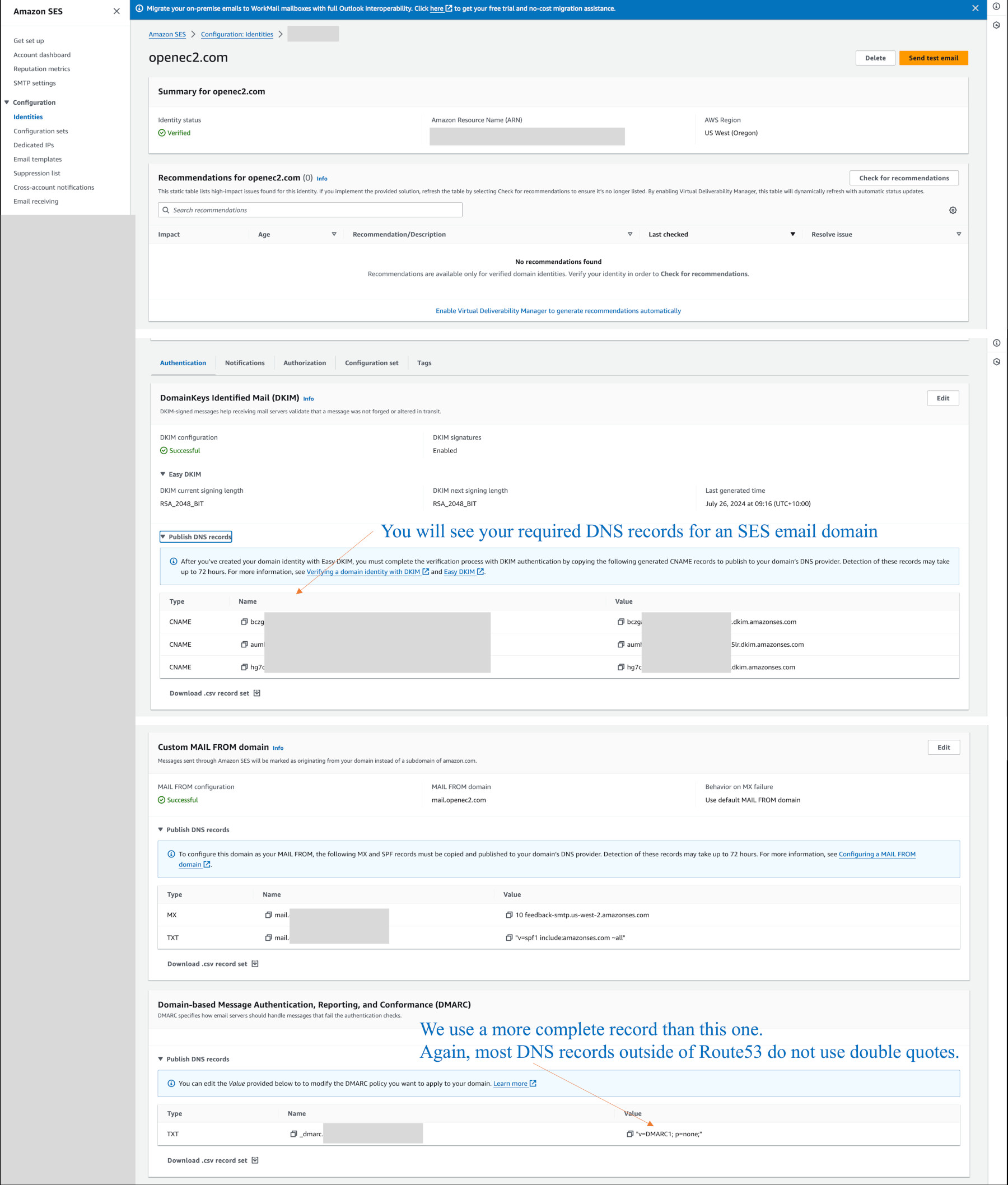openec2 Article Description
Part 3
Configure an SES/S3 Bucket for forwarding email
Open your domain name DNS records, wherever they are held and managed, so that you can add SES email records to them.This is the domain name such as mydomain.com (your own however) which we will add to SES services.
If you do not wish to do so, e.g. your email already goes via MS Exchange, then ignore this. Irrespective, it is good to know how to do this.
You may not mix other email records at the same time with services such as MS Exchange, Amazon WorkMail, VentraIP email, Axigen and so forth.
From your SES console, check you are in your email region, such as Oregon for Australia.
Go to Configuration > Identities > “Create identity” (button) > Identity type – Domain
See the diagram below for the entries we use in the form.
It is easy to make a typo. Amazon checks periodically and sends you an email when the mail from and dmarc records are recognised. You cannot test emails until thee are validated in the SES Identities panel.
Your records will need to have the following, which includes security… (I usually put 3600 as the time interval)
You should already have the CNAME records, www.mydomain.com pointing to domain.com (rather than an ip address).
Three CNAME records, similar to this format:
bczgazcmj366zhkcxxxxxxxxxxxxxxx._domainkey.mydomain.com CAA bczgazcmj366zhkcxxxxxxxxxxxxxxx.dkim.amazonses.com. 3600
mail.mydomain.com MX feedback-smtp.us-west-2.amazonses.com. 3600 10 <– this is the priority, in this case 10.
mail.mydomain.com TXT v=spf1 include:amazonses.com ~all
Note: Amazon Route53 often places values in double quotes. Usually we do not type in a full stop after other provider’s entries either.
mydomain.com MX inbound-smtp.us-west-2.amazonaws.com. 3600 10 <– Note these are with Oregon. Change if needed. Amazon provides a formal list of all its region names.
You cannot include other provider MX records with the same domain name, even if the priority of the one you want is higher, 0 being the highest. We usually use 10, and secondary MX servers 10, 30, and so on.
*._report._dmarc.mydomain.com TXT v=DMARC1
_dmarc.mydomain.com TXT v=DMARC1;p=quarantine;pct=25;rua=mailto:dmarc@mydomain.com
Dmarc records can be handled so they don’t go to your inbox.
MS Exchange would, as an example, give you different records.
Here is an example of the DNS records:
Your domain name is now validated in SES – congratulations
When the domain identity is verified, rather than pending, and we have previously set up our email bucket, we can move on to adding an email address identity and creating an SES receiving rule to place it into the bucket.While this is a lot of work, it becomes okay in the long-run, and validates that you have spent the time to do it and know how to provide a basic service that others would not know how to do. While an entry level cPanel small business site can cost upwards of say, $170 a year or much higher, and while there is more admin work to maintain Amazon AWS, you are leveraging enterprise/government quality systems. A cPanel service can go under strain with ups and downs depending on what the shared users are doing. We also control the security very tightly in Amazon. What you will notice is that shell scripting varies depending on use of Linxux2023 or Debian 11. I do not use Debian 12 at this time even though I have configured it. It is a little different. If using Axigen as an email service on Debian, you are game to own your own service, you have to use Debian 11 X86 (not ARM) and a t3a.micro instance with GP3 disk. Otherwise, we can use Debian (ARM) or Linux 2023 on t4g.micro and GP3. You only use larger instances if using multi-sites, or have a serious business with over 100 visitors a day – you can check the EC2 console for any CPU overload.


